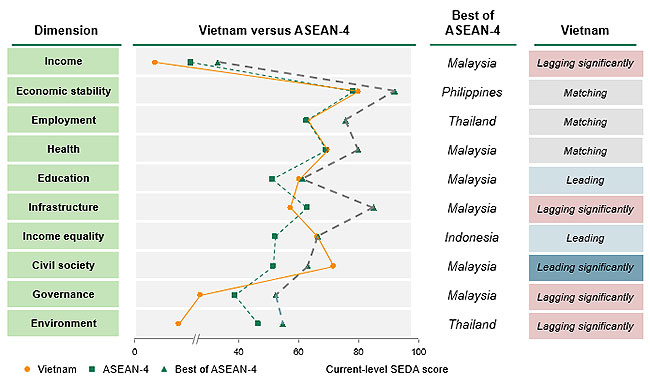Vietnam ranks
4th in the global wealth to well being ratio
Vietnam
ranked fourth out of 149 countries assessed when it comes to converting the
country’s wealth into well-being for its population, according to the finding
of the most recent analysis conducted using The Boston Consulting Group’s
Sustainable Economic Development Assessment (SEDA).

The finding
of the analysis is detailed in BCG’s inaugural SEDA report for Vietnam, Lotus
Nation: Sustaining Vietnam’s Impressive Gains in Well-Being, released
yesterday. According to the report totally sponsored by BCS, Vietnam, with
GDP per capita (based on purchasing-power parity) of approximately $5,200,
has well-being levels that would be expected of a country with GDP per capita
of more than $10,000. Vietnam is also above average in converting economic
growth into well-being improvements.
SEDA is
designed to provide government leaders with a perspective on the well-being
of citizens, including how effectively countries convert wealth, as measured
by income, into well-being and their performance in converting growth into
well-being improvements. SEDA defines well-being—essentially a country’s
standard of living—by examining ten dimensions, such as economic stability,
health, governance, and environment.
“The latest
findings indicate what we have believed all along—that Vietnam’s success in
harnessing its limited resources for the good of its citizens is impressive
and comparable to higher-income countries. This is particularly noteworthy
given the country’s remarkable pace of economic growth of about 7.1 per cent
annually from 2006 to 2013,” said Chris Malone, BCG partner and economic
development expert based in Vietnam.
To ensure
that the country maintains its impressive record, the report suggests action
in three critical areas: employment, infrastructure, and governance.
The report
compares Vietnam’s performance to that of four peer nations that, like
Vietnam, have midlevel incomes: Malaysia, the Philippines, Thailand, and
Indonesia. The group is referred to as the ASEAN 4.
Vietnam
ranks near the bottom of the ASEAN 4 in income, infrastructure, governance,
and environment. And while Vietnam’s score in the employment dimension is in
line with that of its ASEAN 4 peers, the country faces a number of
significant issues in the labour market—including low labour productivity and
a much smaller base of skilled workers—that could create challenges in
sustaining the current pace of development.
“Action in
three areas—employment, infrastructure, and governance—will go a long way
towards determining whether the Vietnamese government can achieve the
ambitious growth targets it has set for itself,” said Malone. “At the heart
of those goals is the aim to move Vietnam from an industrial economy based on
low-cost labour to a modern knowledge-based economy.”
Based on
insights from SEDA, as well as BCG’s experience working with companies and
public-sector leaders in Vietnam, the report identifies concrete actions,
such as upgrading the workforce by improving the links between industry and
providers of training and education, and by steering young people toward
high-demand sectors. The report also recommends a robust performance
management system for the country’s education institutions.
Infrastructure
requires an estimated investment of $113 billion to $140 billion by 2020, but
only 50 per cent to 60 per cent of that can be funded through the
government’s budget. Vietnam can learn from South Korea and India by
improving the way it plans and executes public-private partnerships, in order
to draw in more private-sector investment, and delivering the highest impact
from its investment, the report says.
Improving
governance is key to increasing foreign investors’ confidence in Vietnam and
will require the country to strengthen its institutions and to use digital
tools in order to help increase transparency. The government must also
upgrade the talent in Vietnam’s public service, the report says, and would do
well to model itself on Singapore, where talent management strategies are
powerful means of attracting and retaining high-quality public servants,
including an increasing number of women in leadership roles.
By Hong Anh, VIR
|
Thứ Tư, 23 tháng 3, 2016
Đăng ký:
Đăng Nhận xét (Atom)
Không có nhận xét nào:
Đăng nhận xét